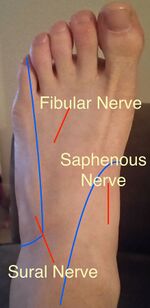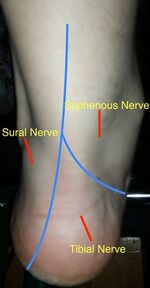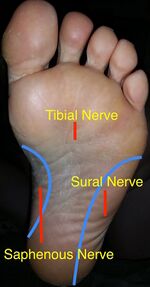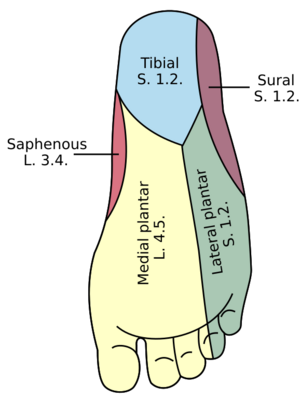⬤
Foot Nerve Blocks
From WikiMSK
Background
- The Emergency Medicine Provider can provide relief using peripheral nerve blocks for a variety of injuries
- Peripheral nerve blocks can reduce pain scores and the need for systemic analgesia [1], potentially decreasing side effects
Indications
- Foot and toe fractures
- Foot Burns
- Foreign Body in the Foot
- Abscess Requiring I&D
- Complex Laceration Repairs
Contraindications
- Overlying site infection
- Injury requiring close neurologic observation (e.g. Compartment Syndrome)
- Allergy to chosen anaesthetic
- Underlying Neurologic Damage
- Uncooperative Patient
Equipment Needed
- 10 cc Syringe with a 27 Gauge Needle
- Spare 18 Gauge Needle (to draw up anesthetic)
- Local Anaesthetic (e.g. Lidocaine vs Bupivacaine)
- Antiseptic (e.g. Chlorhexidine, Betadine, Rubbing Alcohol)
- Sterile Gloves
- Sterile Drape
Procedure[2]
- Discuss the procedure with the patient regarding desired effects and potential complications
- They should be made aware that they will lose both sensory and motor function appropriate distribution until the anaesthetic wears off
- Perform a full motor, sensory, and vascular examination of the targeted area prior to anaesthetic administration
- Place the patient's extremity in a position allowing for easy access to the injection site
- Cleanse the appropriate area of skin with chosen antiseptic
- Create a sterile field using your sterile drape
Posterior Tibial Nerve
- Palpate the Medial Malleolus and Achille's Tendon
- The appropriate site is approximately 1 cm superior to the Medial Malleolus and anterior to the Achille's Tendon
- The injection site should be superior and posterior to the area that the Posterior Tibial pulse is felt
- In a sterile fashion, apply a small wheel of local anaesthetic to this area
- Directing the needle from medial aspect towards lateral, advance the needle with negative pressure applied to the syringe
- It is important to aspirate prior to injecting anaesthetic to rule out Posterior Tibial Arterial placement
- Discontinue and reposition should the patient report shooting "electrical" pains or numbness prior to injection
- Inject approximately 5 mL of local anaesthetic
Superficial Fibular Nerve
- This block will require anaesthetic to be placed across the proximal aspect of the dorsum of the foot from the Medial Malleolus to the Lateral Malleolus
- In a sterile fashion, apply a small wheel of local anaesthetic immediately anterior to the Lateral Malleolus
- Directing the needle medially, advance the needle through the wheel of anaesthetic and advance across the anterior aspect of the foot applying negative pressure to the syringe until the medial aspect is reached
- Discontinue and reposition should the patient report shooting "electrical" pains or numbness prior to injection
- Assuming no blood was aspirated upon advancing the needle, inject approximately 10 mL of anaesthetic as you slowly withdraw the needle
Sural Nerve
- This block is similar to the Posterior Tibial Nerve block, albeit on the lateral aspect of the ankle
- In a sterile fashion, place a wheel of local anaesthetic between the Lateral Malleolus and Achille's Tendon
- Directing the needle from lateral to medial direction, advance the needle with negative pressure applied to the syringe
- Discontinue and reposition should the patient report shooting "electrical" pains or numbness prior to injection
- Inject approximately 5 mL of local anaesthetic to this area
Complications
- Inadvertent intravascular injection
- Infection
- Bleeding/hematoma
- Neurapraxia
References
- ↑ Barreveld,A. et al. Preventive Analgesia by Local Anesthetics: The Reduction of Postoperative Pain by Peripheral Nerve Blocks and Intravenous Drugs. Anesth Analg. 2013; 116(5): 1141-1161.
- ↑ Dillon, DC. et al. Local and Regional Anesthesia. In: Tintinalli JE, Stapczynski J, Ma O, Yealy DM, Meckler GD, Cline DM. eds. Tintinalli’s Emergency Medicine: A Comprehensive Study Guide, 8e. New York, NY: McGraw-Hill; 2016.





